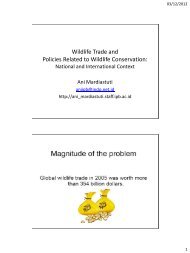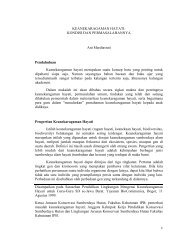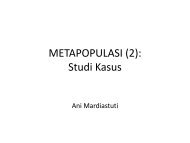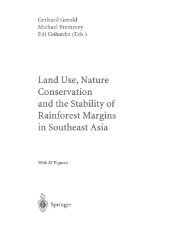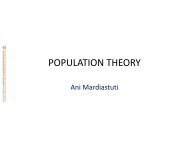Metabolic Rates of Red-Tailed Hawks and Great Horned Owls
Metabolic Rates of Red-Tailed Hawks and Great Horned Owls
Metabolic Rates of Red-Tailed Hawks and Great Horned Owls
Create successful ePaper yourself
Turn your PDF publications into a flip-book with our unique Google optimized e-Paper software.
SHORT COMMUNICATIONS 1001ml/g/hr than males which was 0.566 f 0.080 ml/g/hr(P < 0.05). There was no significant difference in SMR<strong>of</strong> female (0.808 -t 0.236 ml/g/hr) <strong>and</strong> male (0.705 f0.275 ml/e/hr) <strong>Red</strong>-tailed <strong>Hawks</strong>.A nega&e linear relationship (P < 0.001) existedbetween temperature <strong>and</strong> oxygen consumption between-50°C <strong>and</strong> -5°C for both species (Fig. 1). Therate <strong>of</strong> increase <strong>of</strong> oxygen consumption with decreasingtemperatures for <strong>Red</strong>-tailed <strong>Hawks</strong> (mixed sexes) wassignificantly higher (P < 0.01) compared with the ratefor <strong>Great</strong> <strong>Horned</strong> <strong>Owls</strong>. Although there were no dif-ferences in slopes <strong>of</strong> the regression for male <strong>and</strong> female<strong>Great</strong> <strong>Horned</strong> <strong>Owls</strong>, the elevation <strong>of</strong> the metabolic ratefor males was 0.124 ml/g/hr higher (P < 0.05) thanfor females. <strong>Metabolic</strong> rates <strong>of</strong> <strong>Red</strong>-tailed <strong>Hawks</strong> differedby sex, with females having a lower slope thanmales (P < 0.01).Estimated T,< <strong>of</strong> male <strong>and</strong> female <strong>Great</strong> <strong>Horned</strong> <strong>Owls</strong>,17.8”C <strong>and</strong> 24.9”C, were significantly higher (P < 0.01)than 2.1”C <strong>and</strong> 10.7”C for male <strong>and</strong> female <strong>Red</strong>-tailed<strong>Hawks</strong>, respectively.DISCUSSIONBenedict <strong>and</strong> Fox (1927) reported the SMR <strong>of</strong> <strong>Great</strong><strong>Horned</strong> <strong>Owls</strong> as 3.10 W with an average weight <strong>of</strong> 1.45kg which compares favorably with our values <strong>of</strong> 3.03W for female <strong>and</strong> 3.88 W for male <strong>Great</strong> <strong>Horned</strong> <strong>Owls</strong>with an average weight <strong>of</strong> 1.59 kg <strong>and</strong> 1.38 kg, respectively.Kasparie (1983) found that the SMR <strong>of</strong> <strong>Great</strong>Homed <strong>Owls</strong> (mixed sexes, average weight 1.412 kg)was 0.6 cc O,/g/hr (3.50 W).Energy expenditure at thermoneutrality for <strong>Red</strong>-tailed<strong>Hawks</strong> was 6.24 W for females <strong>and</strong> 4.20 W for malesadiusted for body weights. Wasser (1986) renorted thatthe oxygen consumpGon for this species with an averaaeweight <strong>of</strong> 1.475 a was 0.386 cc O,/e/hr (2.15 W).while Haies <strong>and</strong> Gesiaman (1980) gave the‘ value <strong>of</strong>0.42 cc O,/g/hr (2.34 W).A number <strong>of</strong> factors may influence the rate <strong>of</strong> oxygenconsumption <strong>of</strong> an animal including activity, temperature,body size, stage in the life cycle, season <strong>and</strong> time<strong>of</strong> day, sex <strong>of</strong> an animal, <strong>and</strong> genetic background (Prosser1973). Few studies have examined the influence <strong>of</strong>sex on the metabolic rates <strong>of</strong> wild birds. Male Moum-ing Doves (Zenaida macroura) were found to havehigher metabolic rates than females (Riddle et al. 1934)as were male domestic fowl, Gallus gallus (Kibler <strong>and</strong>Brody 1944). No difference was found in the SMR <strong>of</strong>male <strong>and</strong> female Wild Turkeys (Meleagris gallopavo),despite males being larger than females, although metaboliccosts for females below the T,, were greater thanfor males (Gray <strong>and</strong> Prince 1988). Female Mallards(has platyrhynchos) had higher metabolic rates thanmales (Smith <strong>and</strong> Prince 1973).Most raptors, including the two species we studied,have reverse sexual dimorphism (females are biggerthan males). Although sexes <strong>of</strong> <strong>Red</strong>-tailed <strong>Hawks</strong> didnot significantly differ in SMR, female <strong>Great</strong> Homed<strong>Owls</strong> had a lower SMR than males. The heavier female<strong>Great</strong> Homed Owl appears to be a more efficient user<strong>of</strong> energy which could be important in light <strong>of</strong> the earlyreproductive chronology <strong>of</strong> the species. Sex did influencethe rate <strong>of</strong> energy consumption below the T,, <strong>of</strong><strong>Red</strong>-tailed <strong>Hawks</strong>, with the smaller males utilizing in-0.0--oTEMPERATUREFIGURE 1. Oxygen consumption <strong>of</strong> male (n = 4, Y= 0.809 - 0.034T ? 0.005, r2 = 0.73) <strong>and</strong> female (n= 2, Y = 0.954 - 0.020T I!I 0.003, iz = 0.85) <strong>Red</strong>tailed<strong>Hawks</strong> fRTH) <strong>and</strong> male (n = 4. Y = 0.815 -0.14T f 0.001, r* = 0.84) <strong>and</strong>‘female (n = 2, Y =0.691 - 0.014T + 0.001, r2 = 0.90) <strong>Great</strong> Homed<strong>Owls</strong> (GHO) in relation to temperature.creasingly more energy per gram than females. T,, <strong>of</strong><strong>Red</strong>-tailed <strong>Hawks</strong> was the reverse <strong>of</strong> that nredicted forthe species compared to <strong>Great</strong> Homed <strong>Owls</strong>. This appearsto be caused by the lower SMR <strong>and</strong> thus heatproduction <strong>of</strong> <strong>Great</strong> Homed <strong>Owls</strong> which reauired theowls to utilize additional energy for thermoregulationat a higher temperature than the <strong>Red</strong>-tailed <strong>Hawks</strong>.<strong>Great</strong> Homed <strong>Owls</strong> display an energetic advantageover <strong>Red</strong>-tailed <strong>Hawks</strong> in northern climates. They havea lower SMR <strong>and</strong>, more importantly, a lower rate <strong>of</strong>energy production with decreasing temperature whichkeeps the thermoregulatory energy budget <strong>of</strong> <strong>Great</strong><strong>Horned</strong> <strong>Owls</strong> well below that <strong>of</strong> <strong>Red</strong>-tailed <strong>Hawks</strong>.This allows the nonmigratory <strong>Great</strong> <strong>Horned</strong> Owl toendure severe winter conditions more efficiently than<strong>Red</strong>-tailed <strong>Hawks</strong>.We are grateful to J. G. Sikarskie for providing birdsused in this study. S. R. Winterstein assisted with dataanalysis <strong>and</strong> manuscript review. R. W. Hill reviewednroiect findinas. This studv was financed bv the MichiganAgricult;ral Experiment Station <strong>and</strong> is ContributionNo. 13027.LITERATURE CITEDBENEDICT, F. G., AND E. L. Fox. 1927. The gaseousmetabolism <strong>of</strong> large wild birds under aviary life.Proc. Am. Philos. Sot. 66:511.CHAPLIN, S. B., D. A. DIESEL, AND J. A. KASPARIE.1984. Body temperature-regulation in <strong>Red</strong>-tailed<strong>Hawks</strong> <strong>and</strong> &eat Homed <strong>Owls</strong>: responses to airtemperature <strong>and</strong> food deprivation. Condor 86: 175-181.CRAIGHEAD, J. J., AND F. C. CRAIGHEAD, JR. 1969.<strong>Hawks</strong>, owls <strong>and</strong> wildlife. Dover Publications, NewYork.GRAY, B. T., AND H. H. PRINCE. 1988. Basal metab-(VI
1002 SHORT COMMUNICATIONSolism <strong>and</strong> energetic cost <strong>of</strong> thermoregulation inwild turkeys. J. Wildl. Manage. 52: 133-l 37.HAYES, S. R., AND J. A. GESSAMAN. 1980. The combinedeffects <strong>of</strong> air temperature, wind <strong>and</strong> radiationon the resting metabolism <strong>of</strong> avian raptors.J. Therm. Biol. 5:119-125.HILL, R. W. 1972. Determination <strong>of</strong> oxygen consumptionby use <strong>of</strong> a paramagnetic oxygen analyzer.J. Appl. Physiol. 33:261-263.KASPARIE, J.A.J. 1983. Some physiological <strong>and</strong> behavioralresponses <strong>of</strong> the <strong>Great</strong> Homed <strong>Owls</strong> (B&ovirginianus) to winter conditions. M.A.thesis. Univ.<strong>of</strong> Missouri, Columbia.KIBLER, H. H.. AND S. BRODY. 1944. <strong>Metabolic</strong>changes in growing chickens. J. Nutr. 28:27.MCINVAILLE. W. B.. AND L. B. KEITH. 1974. Predatorpreyrelations &d breeding biology <strong>of</strong> the <strong>Great</strong><strong>Horned</strong> Owl <strong>and</strong> <strong>Red</strong>-tailed Hawk-in central Alberta.Can. Field-Nat. 881-20.ORIANS, G., AND F. KUHLMAN. 1956. <strong>Red</strong>-tailedHawk<strong>and</strong> <strong>Great</strong> Homed Owl populations in Wisconsin.Condor 58:371-385.PETERSEN, L. 1979. Ecology <strong>of</strong> <strong>Great</strong> Homed <strong>Owls</strong><strong>and</strong> <strong>Red</strong>-tailed <strong>Hawks</strong> in Southeastern Wisconsin.Wis. Dep. Nat. Resour. Tech. Bull. No. 111.PROSSER, C. L. 1973. Comparative animal physiology.W. B. Saunders Company, Philadelphia.RIDDLE O., G. C. SMITH, AND F. G. BENEDI~. 1934.Seasonal <strong>and</strong> temperature factors <strong>and</strong> their determinationsin pigeons <strong>of</strong> percentage metabolismchange per degree <strong>of</strong> temperature change. Am. J.Physiol. 107:333.SMITH, K. G., AND H. H. PRINCE. 1973. The fastingmetabolism <strong>of</strong> subadult Mallards acclimatized tolow ambient temperatures. Condor 75330-335.WASSER, J. S. 1986. The relationship <strong>of</strong> energetics <strong>of</strong>falconiform birds to body mass <strong>and</strong> climate. Condor88:57-62.ZAR, J. H. 1973. Using regression techniques for predictionin homeothe& bioenergetics, p. 115-l 33.IN J. A. Gessaman led.1. Ecological enernetics <strong>of</strong>homeotherms: a view compatible with e&logicalmodeling. Utah State Univ. Monogr. Ser. 20.The Condor 91:1002-10050 The Cooper Ornithological Society 1989ANALYSIS OF A DIALECT BOUNDARY IN CHACO VEGETATION INTHE RUFOUS-COLLAREDSPARROW’S. C. LCXJGHEED, A. J. LOUGHEED, M. RAE, AND P. HANDFORDDepartment <strong>of</strong> Zoology, University <strong>of</strong> Western Ontario, London, Ontario, Canada N6A 5B7Key words: Dialects; vocalizations; Rufous-collaredSparrow: Zonotrichia capensis.Examinations <strong>of</strong> the relationship between culturallytransmitted traits, like bird song, <strong>and</strong> ecological attributesare particularly important in the study <strong>of</strong> aviansong dialects. Correlation between habitat <strong>and</strong> birdsong is the foundation <strong>of</strong> the genetic adaptation hypothesisdeveloped by Nottebohm (1972). In the geneticadaptation hypothesis, a dialect functions as arecognition signal among individuals <strong>of</strong> a local populationwhich is adapted to a particular habitat <strong>and</strong> whichis genetically distinct from neighboring populations indifferent habitats (Payne 198 1). Such ecological correlatesmay also reflect adaptation <strong>of</strong> song characteristicsto acoustic properties <strong>of</strong> different habitats (theacoustic adaptation hypothesis, e.g., Wiley <strong>and</strong> Richards1982). There are a number <strong>of</strong> studies in whichcorrelations between bird song <strong>and</strong>habitat have beenexamined. For example Baker et al:’ (1982) found norelationship between four dialects in Zonotrichia leu-I Received 14 April 1989. Final acceptance 6 July1989.cophrys nutalli <strong>and</strong> the coastal scrub vegetation <strong>of</strong> theirstudy area, although the dialect populations appearedto be genetically differentiated to some degree. Hunter<strong>and</strong> Krebs (1979) suggested that differences in territorialsongs <strong>of</strong> Purus major, the <strong>Great</strong> Tit, betweendense forest <strong>and</strong> open woodl<strong>and</strong> were, in part, due todifferences in acoustic characteristics <strong>of</strong>their respectivehabitats.The occurrence <strong>of</strong> vocal dialects in the Rufous-col-lared Sparrow, Zonotrichia capensis, has been well documented(Nottebohm 1969, 1975; King 1972; H<strong>and</strong>ford<strong>and</strong> Nottebohm 1976). The typical song <strong>of</strong> Z.capensis consists <strong>of</strong> an introductory theme with betweenone <strong>and</strong> five whistled notes, followed by a trill,a series <strong>of</strong> similar, briefnotes (Nottebohm 1975). Nottebohm(1975) <strong>and</strong> H<strong>and</strong>ford (1981, 1988) have demonstrateda consistent association between the rate <strong>of</strong>the terminal trill (the dialect-discriminating variable)<strong>and</strong> vegetation over a large area in northwestern Argentina.However, there have been few fine-grainedanalyses <strong>of</strong> dialect boundaries (Nottebohm 1975,H<strong>and</strong>ford <strong>and</strong> Nottebohm 1976). In these studies, dialectboundaries were usually sharply demarcated <strong>and</strong>located in areas where vegetation types changed rapidly.Here we provide a detailed description <strong>of</strong> a dialect





